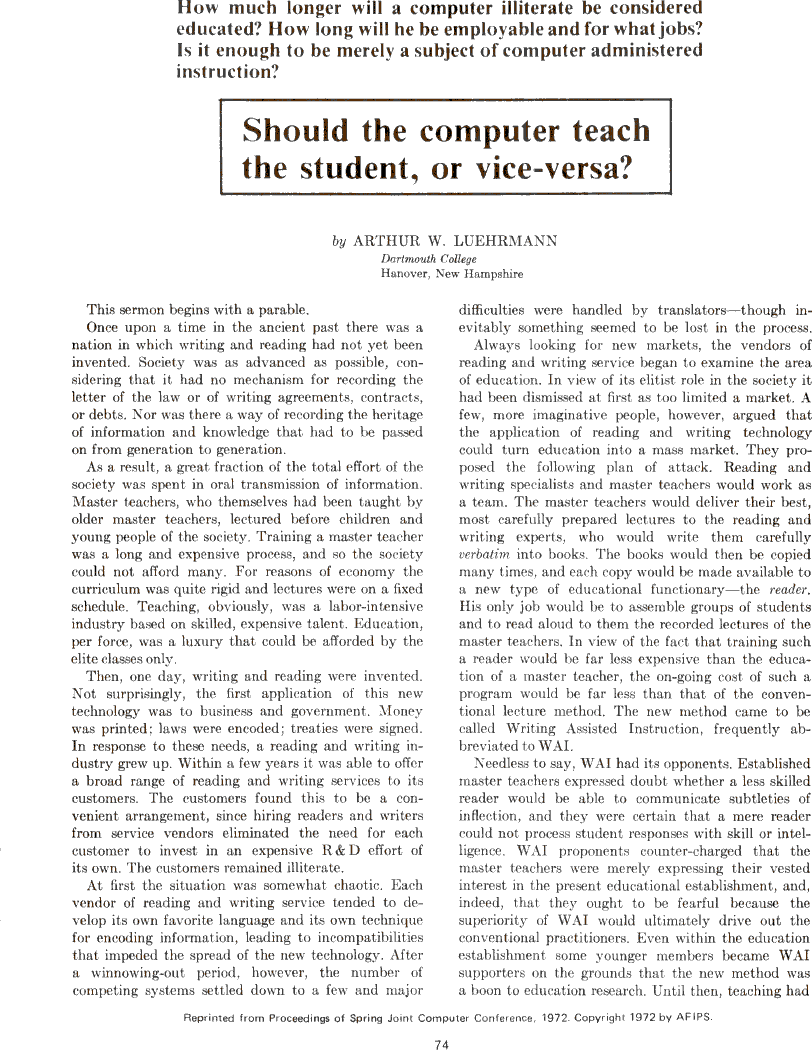by Arthur W. Luehrmann

How much longer will a computer illiterate be considered educated? How long will he be employable and for what jobs? ls it enough to be merely a subject of computer administered instruction? Should the computer teach the student, or vice-versa? by ARTHUR W. LUEHRMANN Dartmouth College Hanover, New Hampshire This sermon begins with a parable. Once upon a time in the ancient past there was a nation in which writing and reading had not yet been invented. Society was as advanced as possible, considering that it had no mechanism for recording the letter of the law or of writing agreements, contracts,or debts. Nor was there a way of recording the heritage of information and knowledge that had to be passed on from generation to generation. As a result, a great fraction of the total effort of the society was spent in oral transmission of information. Master teachers, who themselves had been taught by older master teachers, lectured before children and young people of the society. Training a master teacher was a long and expensive process, and so the society could not afford many. For reasons of economy the curriculum was quite rigid and lectures were on a fixed schedule. Teaching, obviously, was a labor-intensive industry based on skilled, expensive talent. Education,per force, was a luxury that could be afforded by the elite classes only. Then, one day, writing and reading were invented. Not surprisingly, the first application of this new technology was to business and government. Money was printed; laws were encoded; treaties were signed. In response to these needs, a reading and writing industry grew up. Within a few years it was able to offer a broad range of reading and writing services to its customers. The customers found this to be a convenient arrangement, since hiring readers and writers from service vendors eliminated the need for each customer to invest in an expensive R&D effort of its own. The customers remained illiterate. At first the situation was somewhat chaotic. Each vendor of reading and writing service tended to develop its own favorite language and its own technique for encoding information, leading to incompatibilities that impeded the spread of the new technology. After a winnowing-out period, however, the number of competing systems settled down to a few and major difficulties were handled by translators-though inevitably something seemed to be lost in the process. Always looking for new markets, the vendors of reading and writing service began to examine the area of education. In view of its elitist role in the society it had been dismissed at first as too limited a market. A few, more imaginative people, however, argued that the application of reading and writing technology could turn education into a mass market. They proposed the following plan of attack. Reading and writing specialists and master teachers would work as a team. The master teachers would deliver their best,most carefully prepared lectures to the reading and writing experts, who would write them carefully verbatim into books. The books would then be copied many times, and each copy would be made available to a new type of educational functionary-the reader. His only job would be to assemble groups of students and to read aloud to them the recorded lectures of the master teachers. In view of the fact that training such a reader would be far less expensive than the education of a master teacher, the on-going cost of such a program would be far less than that of the conventional lecture method. The new method came to be called Writing Assisted Instruction, frequently abbreviated to WAI. Needless to say, WAI had its opponents. Established master teachers expressed doubt whether a less skilled reader would be able to communicate subtleties of inflection, and they were certain that a mere reader could not process student responses with skill or intelligence. WAI proponents counter-charged that the master teachers were merely expressing their vested interest in the present educational establishment, and, indeed, that they ought to be fearful because the superiority of WAI would ultimately drive out the conventional practitioners. Even within the education establishment some younger members became WAI supporters on the grounds that the new method was a boon to education research. Until then, teaching had Reprinted from Proceedings of Spring Joint Computer Conference. 1972. Copyright 1972 by AFIPS.

